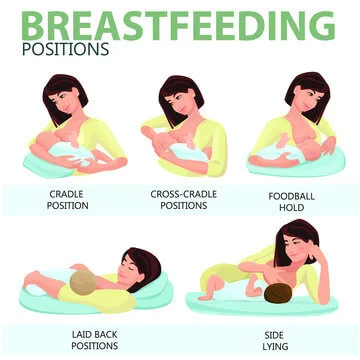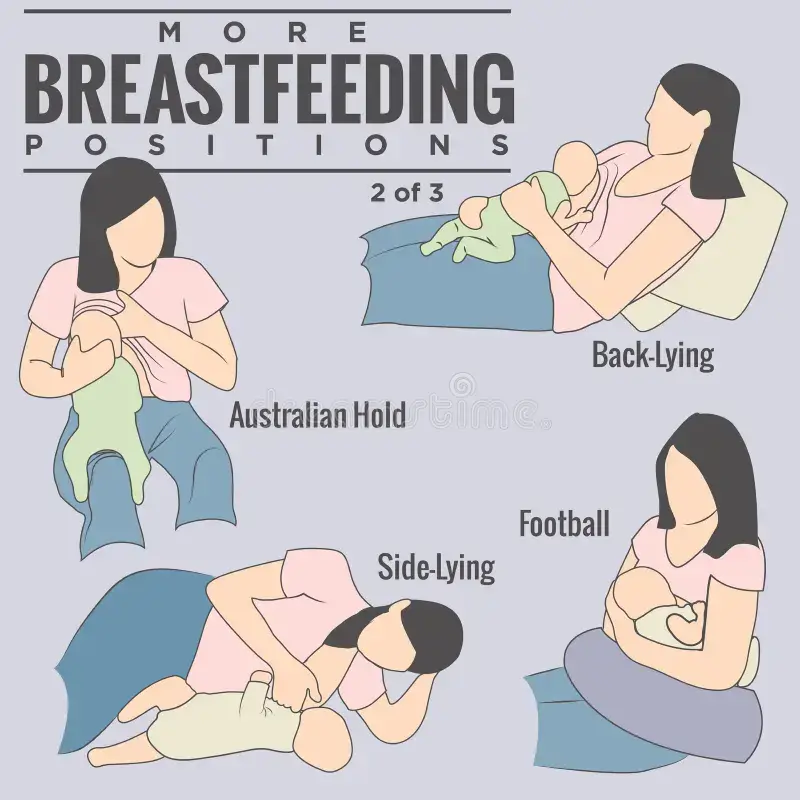Introduction
Breastfeeding Positions : Breastfeeding is a natural yet learned skill that requires proper positioning and attachment to ensure both mother and baby can enjoy a comfortable and effective feeding experience. Positioning refers to how a mother holds her baby during breastfeeding, while attachment (or latch) describes how the baby takes the breast into their mouth. Understanding and mastering these fundamental aspects is crucial for successful breastfeeding.
Getting these elements right from the start can prevent common challenges such as nipple soreness, inadequate milk transfer, and feeding difficulties. When positioning and attachment are optimal, babies can effectively extract milk while mothers remain comfortable, leading to a positive breastfeeding journey.
Achieving a Proper Latch
Nipple Sensitivity in Early Days
Most mothers experience some degree of nipple sensitivity when they first start breastfeeding. This sensitivity typically peaks on the third to fifth day after birth and gradually diminishes as breastfeeding becomes established. However, persistent pain or damage to the nipples often indicates the need to adjust positioning or attachment.
Common experiences during the early days include:
- Tenderness when the baby first latches
- Brief discomfort that subsides as feeding progresses
- Mild sensitivity between feeds
- Temporary sensitivity to clothing or shower water

Methods of Attaching Baby
Baby-led Approach
The baby-led approach, also known as biological nurturing or laid-back breastfeeding, harnesses your baby’s natural feeding instincts. When placed skin-to-skin on their mother’s chest, babies display remarkable abilities to find the breast and attach themselves.
This instinctive process typically follows these steps:
- Place baby skin-to-skin on mother’s chest
- Allow baby to bob and weave their head, seeking the breast
- Support baby’s shoulders and bottom while they explore
- Wait for the baby to open their mouth wide and self-attach
- Ensure baby has the freedom to adjust their position as needed
The baby-led approach offers several advantages:
- Reduces pressure on both mother and baby
- Encourages natural feeding behaviors
- Promotes optimal positioning through the baby’s instincts
- Strengthens the bond between mother and baby
Mother-led Approach
The mother-led approach involves actively guiding your baby to attach to the breast. This method can be particularly helpful when learning to breastfeed or addressing specific challenges.
Key steps in the mother-led approach include:
- Position yourself comfortably with good back support
- Hold baby close, ensuring their neck and shoulders are supported
- Align baby’s nose with your nipple
- Wait for the baby to open wide, like a yawn
- Quickly bring baby to breast, leading with their chin
- Ensure baby takes a large portion of the areola, not just the nipple
Breastfeeding Positions
Importance of Finding a Comfortable Position
A comfortable position is fundamental for successful breastfeeding. The right position helps prevent muscle strain, ensures effective milk transfer, and makes feeding sessions more enjoyable for both mother and baby.
Essential elements of a comfortable position include:
- Good back support for the mother
- Minimal tension in shoulders and arms
- Baby’s body is aligned and supported
- Easy access to the breast without straining
- Ability to maintain the position throughout the feed
Types of Breastfeeding Positions

Laid-back Position
The laid-back position mimics natural feeding behaviors and can be particularly soothing in the early days of breastfeeding. This position involves reclining at a comfortable angle, and supporting your back with pillows.
Tips for successful laid-back feeding:
- Find a comfortable recline angle (45-65 degrees typically works well)
- Ensure your entire back and head are supported
- Place baby tummy-down on your chest
- Allow baby to seek the breast naturally
- Support baby’s bottom and shoulders as needed
Cross-cradle Hold
The cross-cradle hold offers excellent control and visibility, making it popular for learning to breastfeed. This position entails using the hand opposite the feeding breast to support your baby’s head and neck.
Guidance for the cross-cradle hold:
- Support baby’s neck and shoulders with your palm
- Keep baby’s ear, shoulder, and hip aligned
- Position baby’s nose level with your nipple
- Use pillows to bring baby to breast height
- Maintain a relaxed grip to avoid neck tension
Koala Hold (Straddle-hold)
The koala hold positions baby upright, straddling your thigh or hip while facing the breast. This position can be particularly beneficial for babies with reflux or a preference for upright feeding.
Key aspects of the koala hold:
- Support baby’s bottom and back while they sit upright
- Ensure baby’s head can tip back slightly
- Position baby’s chest against your body
- Allow natural head movement for latching
- Monitor baby’s stability throughout the feed
Football Hold
The football hold, where a baby’s body tucks under your arm like a football, proves especially useful after a cesarean birth or for mothers with large breasts.
Implementation tips:
- Support baby’s neck and shoulders with your hand
- Tuck baby’s legs under your arm
- Support your arm and the weight of your infant with pillows.
- Keep baby’s ear, shoulder, and hip aligned
- Position baby slightly lower than the nipple initially
Side-lying Position
The side-lying position allows for restful feeding sessions and proves invaluable for night feeds. On their sides, facing one another, lie the mother and the infant.
Steps for successful side-lying feeding:
- With cushions supporting your back, lie on your side.
- Position baby facing you, tummy-to-tummy
- Align baby’s nose with your nipple
- Support baby’s back to maintain position
- Ensure baby’s airway remains clear
Ensuring a Correct Latch
Signs of Correct Attachment
Recognizing proper attachment helps ensure effective feeding and prevent complications. Key indicators include:
Baby’s mouth and chin position:
- Chin pressed into the breast
- Nose free from breast tissue
- Wide mouth opening around the areola
- More areola visible above upper lip than below
Lip and cheek appearance:
- Lips flanged outward
- Cheeks full and rounded
- No dimpling or sucking in of cheeks
- Smooth movement during sucking
Sucking patterns and sounds:
- Deep, rhythmic sucking
- Audible swallowing after milk lets down
- Pauses for breathing
- No clicking or smacking sounds
Baby’s behavior:
- Relaxed body position
- Steady sucking rhythm
- Regular swallowing
- Satisfied after feeding
- Adequate wet and soiled diapers
Mother’s comfort:
- Initial tugging sensation normal
- No persistent nipple pain
- No damage to nipple tissue
- Breast softening during feed
Things to Avoid During Latching
To prevent complications and ensure effective feeding, avoid:
- Pushing baby’s head toward the breast
- Holding the back of the baby’s head
- Pinching or shaping the breast too firmly
- Allowing baby to attach with a shallow latch
- Continuing to feed through significant pain

Conclusion
Mastering positioning and attachment takes practice and patience. Remember that every mother-baby pair is unique, and what works best may vary. Don’t hesitate to seek support from lactation consultants or breastfeeding specialists if challenges arise.
Frequently Asked Questions About: Breastfeeding Positions and Attachment
How can I determine whether my infant is receiving enough milk?
Your baby is likely getting enough milk if they:
- Have 6-8 wet diapers per day after the first week
- By 2 weeks of age, return to their birth weight.
- Appear satisfied after feeds
- Show steady weight gain during check-ups
- Feed 8-12 times in 24 hours
- Make swallowing sounds during active feeding
What should I do if breastfeeding hurts?
While some initial tenderness is normal, persistent pain usually indicates an adjustment is needed:
- Check your baby’s latch and positioning
- Break the suction and try again if the latch feels uncomfortable
- Consult a lactation consultant for personalized guidance
- Try different positions to find what works best
- Apply expressed breast milk to sore nipples after feeding
- Consider using purified lanolin if recommended by your healthcare provider
How long should each feeding session last?
Every baby is different, but typically:
- Newborns may feed for 20-45 minutes per session
- Older babies become more efficient, often completing feeds in 10-20 minutes
- Let your baby set the pace and feed until they show signs of being finished
- Avoid timing feeds strictly; instead, watch for signs of satisfaction
What if my baby falls asleep while feeding?
If your infant frequently nods off while being breastfed:
- Try skin-to-skin contact to keep them alert
- Gently compress your breast to encourage milk flow
- Switch sides when sucking slows
- Use gentle stimulation (stroking feet, changing diaper) to wake them
- Consider undressing them during feeds to keep them alert
How can I tell if my baby is latched correctly?
Signs of a good latch include:
- No pain after the initial seconds of latching
- Baby’s chin pressed into the breast
- Baby’s lips flanged outward like fish lips
- Rhythmic suck-swallow-breathe pattern
- You can see or hear swallowing
- Baby’s ears wiggle slightly during feeding
What positions work best after a C-section?
After a cesarean birth, try these positions:
- Football hold to keep pressure off your incision
- Laid-back position with baby supported by pillows
- Side-lying position once you can move comfortably
- Use extra pillows for support as needed
- Consider using a breastfeeding pillow for additional comfort
How do I manage feeding twins?
When breastfeeding twins:
- Learn to feed one baby well before trying tandem feeding
- Use the football hold for tandem feeding
- Invest in a specialized twin nursing pillow
- Consider alternating breasts between babies
- Keep track of feeding times and sides for each baby
- Accept help during feeding sessions when possible
What if my baby refuses certain positions?
If your baby shows position preferences:
- Respect their preference initially to establish confidence
- Gradually introduce new positions during calm times
- Try skin-to-skin contact in different positions
- Make changes slowly and observe their response
- Consider if there might be physical reasons for the preference
How do I maintain good posture while breastfeeding?
To protect your back and shoulders:
- Always bring the baby to breast height
- Use pillows to support your arms and back
- Keep your feet supported flat on the floor
- Avoid hunching over your baby
- Consider using a nursing stool to elevate your feet
- Take breaks to stretch and move between feeds
If my infant is distracted when I’m feeding them, what should I do?
For easily distracted babies:
- Feed in a quiet, dimly lit room
- Use a nursing cover if comfortable
- Choose times when baby is calm but alert
- Maintain skin-to-skin contact
- Consider white noise to mask background sounds
- Feed before the baby becomes overtired
How can I make night feeding more comfortable?
For easier night feeds:
- Master the side-lying position
- Keep necessities within reach
- Use dim lighting
- Consider co-sleeping safely according to guidelines
- Prepare your feeding station before going to bed
- Keep water and snacks nearby
When should I seek professional help?
Consult a lactation consultant if you experience:
- Persistent nipple pain or damage
- Difficulty getting baby to latch
- Concerns about milk supply
- Baby’s slow weight gain
- Recurring blocked ducts or mastitis
- Any persistent breastfeeding challenges

